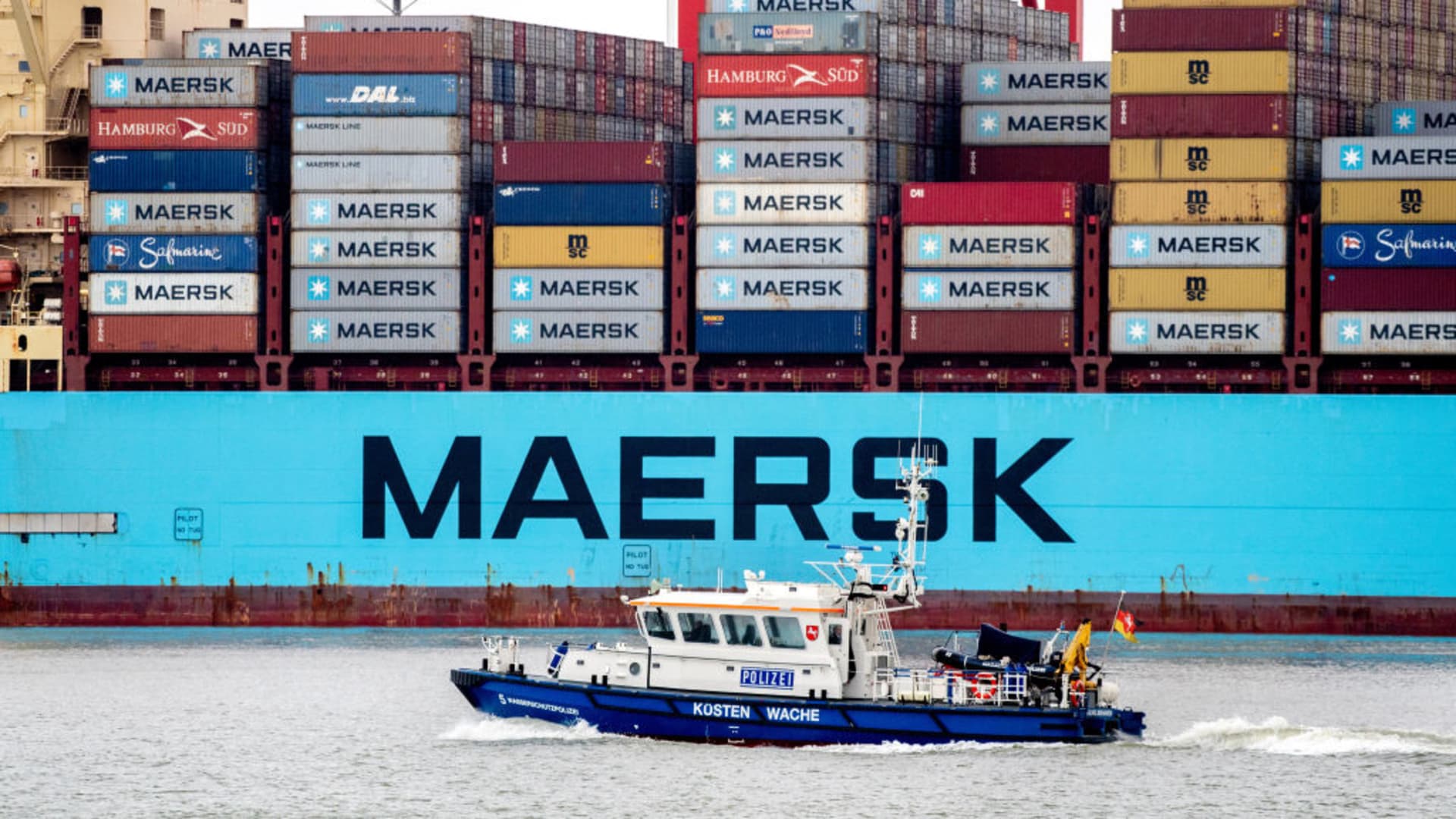The Hamburg flag flies in front of Hapag-Lloyd containers on the Hapag-Lloyd containership “Berlin Express” at Burchardkai in the Port of Hamburg.
Marcus Brandt | Picture Alliance | Getty Images
MSC, the world’s largest shipping carrier, said it is no longer traveling through the Suez Canal after its container ship, the MSC PALATIUM III, was attacked Friday while transiting the Red Sea under a subcharter to Messina Line.
“Due to this incident and to protect the lives and safety of our seafarers, until the Red Sea passage is safe, MSC ships will not transit the Suez Canal Eastbound and Westbound. Already now, some services will be rerouted to go via the Cape of Good Hope instead.”
MSC explained the new routing will impact the sailing schedules by several days for vessels booked for Suez transit. “We ask for your understanding under these serious circumstances,” the advisory continued.
This announcement follows the announcement in the pause of Red Sea and Bab al-Mandeb Straight travel by shipping giants, Hapag-Lloyd and Maersk, following a series of attacks on their vessels by Iranian-backed Houthi militants from Yemen.
Maersk, the world’s second-largest container shipping company, moves 14.8% of the world’s trade. It said it would divert ships away from the Red Sea. The Houthi group backs Hamas, the Palestinian militant group, and has said it is targeting vessels headed for Israel.
In an email to CNBC, a Maersk spokesman said the Danish company is deeply concerned about the highly escalated security situation in the southern Red Sea and Gulf of Aden. The recent attacks on commercial vessels in the area are alarming and pose a significant threat to the safety and security of seafarers, the spokesman added, saying that employees’ safety is the company’s top priority.
“Following the near-miss incident involving Maersk Gibraltar yesterday and yet another attack on a container vessel today, we have instructed all Maersk vessels in the area bound to pass through the Bab al-Mandab Strait to pause their journey until further notice,” the representative said.
Maersk said it would release more details about potential next steps in the coming days.
Hapag-Lloyd, which controls about 7% of the global container ship fleet, told CNBC in an email, that it will “pause all container ship traffic through the Red Sea until Monday. Then we will decide for the period thereafter.”
The Bab el-Mandeb Strait is between the Horn of Africa and the Middle East. It connects the Red Sea to the Gulf of Aden and the Arabian Sea, which feed into the Indian Ocean. This waterway is used by container ships and exports of petroleum and natural gas from the Persian Gulf.
Approximately 12% of the world’s trade, which includes 30% of all global containers, move through the Suez Canal. That then feeds through the Red Sea and Bab el-Mandeb. The significance of the Suez Canal was thrust into the spotlight in March 2021, when the container ship Ever Given was stuck for six days.
A boat of the Lower Saxony water police sails along in front of the container ship “Morten Maersk” of the Danish shipping company Maersk Line, which is moored at a quay wall at the container terminal JadeWeserPort.
Picture Alliance | Getty Images
The collective vessel market share of MSC, Hapag Lloyd, and Maersk is approximately 40% of global trade. The decrease in vessel transits by these three ocean carriers will be a financial hit to Egypt, which owns, operates, and maintains the Suez Canal. The Suez Canal Authority (SCA) announced a record $9.4 billion was generated in the 2022-2023 fiscal year. Increasing Suez Canal transit fees and tourism revenue play a crucial role, in Egypt’s struggling economy. Egypt has already seen a hit in tourism due to the Israel/ Hamas War.
The SCA announced in October it would increase transit fees in mid-January by 5%-15%. The Suez Canal was seeing additional vessels transiting the waterway as vessels were diverting away from the Panama Canal due to drought restrictions.
Israel-based ocean carrier ZIM has re-routed vessels to avoid the Arabian and Red Seas to safeguard their vessels and crew amid the threats by the Houthis. The vessels are traveling around the Cape of Good Hope in South Africa. This alternative route to the Indian Ocean adds 10 to 14 days of travel time to a vessel’s journey. The long way around Africa also incurs higher fuel costs because of the longer travel distance.
Since Houthi militants threatened Saturday to attack any vessels that have ownership ties to Israel or do business in the country, there have been as many as seven incidents. Overall, 13 vessels have been attacked since the Israel-Hamas war began in early October.
In response to Friday’s attacks, in which three vessels were attacked, the World Shipping Council said it is deeply alarmed and concerned about the escalating crisis, and that it’s calling for decisive action to protect seafarers.
“The right of freedom of navigation stands as a fundamental right under international law, and must be safeguarded,” the council said. “The time for resolute international engagement is now.”
The U.S. government has been in discussions with countries of the 39-member Combined Maritime Forces to form a maritime task force to “ensure safe passage” of ships in the Red Sea.
U.S. Central Command, which oversees America’s military interests in the Middle East, has told CNBC discussions are ongoing.








